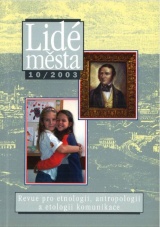„Tleskací hry"
Ukázka variačního procesu
DOI:
https://doi.org/10.14712/12128112.4282Abstrakt
The text is devoted to the question of form and transformation of one type of children's plays - the clapping plays (Klatschspiele in German). lt introduces as
well as analyses a material which was collected at the end of the 20th and beginning of the 21st centuries among the children in Prague and other Czech towns. "Clapping plays" is a relatively newly clear-cut and at the same time stabilised type of plays, although one can also observe in it a series of genetic or formal agreements with the plays which had been described by collectors in the past among children and youth in traditional regions of Bohemia and Moravia (mostly nursery rhymes and counting-out rhymes, but not only these). Research has set this type of children's plays in the environment of the Czech small town in the 1930s. In the Czech academic community, they were first highlighted by Jana Pospíšilová in the 1990s. In the present-day playing repertory of children, clapping plays constitutes one of the few types of plays which combine an advanced verbal part with the kinetic part. As one can see, the play is based on rhythm, which is defined by the recitation of a nursery rhyme or the singing of a song. Rhythm and subsequently tempo are then determined by the movement of hands - clapping and figures (imitating gestures). From the viewpoint of the motion of hands, there are three types - three ways of clapping plays. The differences in the modes of clapping are not just formal, but they are also connected with the sense (objective) of a game. These are therefore (1) the plays played in a couple, based on the harmonisation of the motion of the fellow players; (2) the plays, which are devised to eliminate an inattentive player at the end of a game; and (3) the plays which are a race of who will execute the whole set of clapping by hands and figures the fastest and without any faults. The research of the verbal part of clapping hands has collected a number of variants. Their analysis has prompted the examination of the following question: the variation process of children's folklore. lt also assesses it in the context of the present-day life of folklore in Czech society. ln this sense, children's plays still make part of the live folklore. They are still guided by the rules and tendencies of performance, transmission and transformation of a folkloric work. They thus bear in themselves the phenomena which have been lost by the traditional "big" folklore genres. The fact that there is no established form in the performance of children's plays, allows a "free" development of all of its parts. From the viewpoint of the variations of the verbal part of the clapping plays, one can see changes both on the horizontal level - the form of strophes and rhymes (mutation, affinity), and on the vertical level - the order of strophes and rhymes in a text (amplification, reduction, destruction, contamination, combination). Although it is uneasy to interpret the direction of movement in the development of a certain play and ascertain the sequence of individual steps of the variation process on the one hand, it is a sort of discovery to examine all the modalities of the transformation of the verbal part of the play in children's culture and its tendencies. In this respect, one can discern two major pieces of new knowledge. First, it is the tendency of "Czechisization" of rhymes - both from imaginary or corrupt words. Second, there is the hypertrophy or ramification of certain selected motives, both in the form of the repetition according to a pattern, or in the form of added intersections, as a means with an intensified content.
Stahování
Publikováno
Jak citovat
Číslo
Sekce
Licence

Tato práce je licencována pod Mezinárodní licencí Creative Commons Attribution-NonCommercial-NoDerivatives 4.0.


